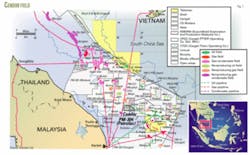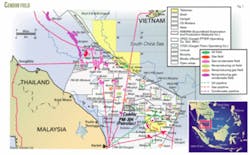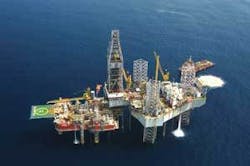A refurbished mat-supported jack up mobile oil production unit (MOPU) recently began operating in 63 m of water on the Cendor oil field in Block PM304 off Malaysia (Fig. 1).
Petrofac Malaysia, a unit of Petrofac Ltd. UK, operates the field.
Phase 1 of the project includes seven dry-tree well completions on the MOPU that produce oil to a spread-moored floating storage and offloading vessel (FSO) through a flexible subsea pipeline.
Richard Hall, vice-president of operations and development for Petrofac’s resources division and general manager of Petrofac Malaysia, told OGJ that one factor that made this low-cost development solution possible for this marginal field was the level seabed at Cendor that allowed installation of the mat-supported MOPU.
The field currently produces 12,000 bo/d and Petrofac says that the field contains about 24.6 million bbl of recoverable 41.5° gravity oil.
Petrofac has a 30% interest in the field. Other interest owners are Petronas Carigali Sdn. Bhd. 30%, Kuwait Foreign Petroleum Exploration Co. (Kufpec) 25%, and PetroVietnam Investment Development Co. (PIDC) 15%.
Kufpec is a wholly owned subsidiary of Kuwait National Oil Co. and PIDC is a wholly owned subsidiary of Petro Vietnam.
Petrofac
Hall described Petrofac as a company involved in three different types of oil field operations. The company has an engineering, and construction group with main locations in Woking, Sharjah, and Mumbai; a facilities management and training group that primarily works off the UK for companies that recently have purchased producing properties from larger companies; and an investment group that holds interests in oil and gas producing properties or infrastructure, aligned to its client and partner base.
Petrofac currently has interests in oil and gas field developments in Tunisia, Algeria, and off the UK. Cendor is the first field in which it is the operator under a joint operating team arrangement with Petronas Carigali.
Cendor project
Hall said that Petrofac had been able to take the Cendor project from “farm-in to full production in less than 2 years in a tight market, within budget, and ahead of the prescribed timetable.”
Over the years, four different operating companies have drilled about 11 exploration wells in the block since the 1970s with only the most recent operator, Hess encountering hydrocarbon production potential.
Hess’ Cendor-1 had a 1,790-m TD and tested up to 2,840 b/d of 42° gravity oil from one zone, with another zone flowing more than 5 MMscfd of gas (OGJ Online, Mar. 23, 2001).
Petrofac describes the Cendor structure as a large inversion anticline compartmentalized by a number of north-south trending faults. The principal reservoirs in the first development phase are the H15 and H20 intervals within the Middle Miocene formations that are highly stratified and vary between muddy hetereolithics, sandy hetereolithics, and clean sands.
Previous operators considered the field marginal because of the uncertainties associated with the extent of reservoir compartmentalization and the relative productivities of the different facies that caused difficulties with formulating a development plan.
Another problem in delineating the field was the presence of shallow gas that inhibits resolution of seismic horizons across the structural crest at reservoir depth.
Key to Petrofac’s development was to obtain operational flexibility for dealing with as many potential reservoir outcomes as possible at the lowest possible cash commitment, Hall said.
He described the previous development schemes as assuming lightweight platforms with limited flexibility. Petrofac on the other hand noted that the seabed at Cendor is flat, which made installation of an old style mat-supported drilling rig as a production platform commercially feasible.
Petrofac leases the unit and also the FSO, which adds to the flexibility.
The MOPU has a deck area that accommodates two first-stage separators as well as a test unit. It can process up to 20,000 bo/d but has a turndown design to produce as little as 2,000 bo/d, which at high oil prices is economic, according to Hall.
The well completions have triple splitter wellheads, so that the MOPU effectively has 12 well slots within four 36-in. by 1¼-in. WT conductors.
The deck has sufficient deck space for a laydown area to carryout workovers with a hydraulic workover unit.
Petrofac also has had the mud pumps refurbished and installed the required piping in case the oil from the wells needs to be artificially lifted with jet pumps. The MOPU also has the capability to inject 25,000 bw/d.
The wells produce with a 250 scf/bbl GOR.
Petrofac uses carbon steel tubulars in the wells and injects chemical downhole to prevent corrosion.
A low-cost flexible composite subsea hose, installed from a motorized reel on a small dynamically positioned vessel, connects the MOPU to the FSO. Manuli Rubber Industries, Milan, Italy manufactured the hose.
Hall said the project has the following innovative firsts for Malaysia:
- First MOPU.
- Longest span of unsupported conductor, 80 m.
- First flexible subsea pipeline made of composite material.
Petrofac’s next plan is to evaluate reservoir performance to rapidly progress further development and to drill an appraisal well on the other side fault block where only one dry hole was drilled, Hall said.


